
The Universalist Society Meetinghouse is an historic Greek Revival meetinghouse at 3 River Road in Orleans, Massachusetts. Built in 1834, it was the only Universalist church built in Orleans, and is architecturally a well-preserved local example of Greek Revival architecture. The Meeting House is now the home of the Orleans Historical Society and is known as the Meeting House Museum. It was listed on the National Register of Historic Places in 1999.
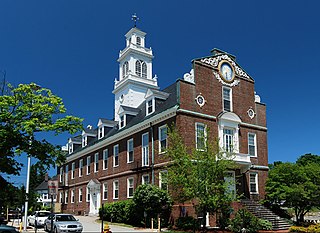
The Weymouth Civic District is a historic district encompassing the main civic area in Weymouth, Massachusetts. It is anchored by the 1928 Town Hall, which is a slightly reduced-scale replica of the Old State House in Boston, and the Legion Field athletic complex. Most of the houses built in the area along Middle Street between and surrounding these anchors were built between 1850 and 1920. To the south of town hall is a memorial wall, on which are plaques commemorating the town's military. The oldest building in the district is the 1926 Tudor Revival Weymouth Industrial School building, located next to the middle school.
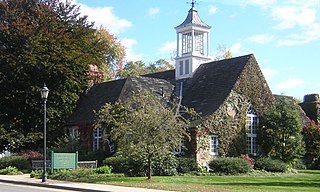
The Wellesley Hills Branch Library is a historic library building at 210 Washington Street in Wellesley, Massachusetts. The stone building was designed in 1927 by Hampton F. Shirer, whose plans were developed from the sketches of the late Ralph H. Hannaford, and completed in 1928. The Colonial Revival building is L-shaped, with single story above a raised basement. It is faced in local fieldstone. The main block has a five-bay side-gable configuration with a projecting entry pavilion. It is the town's first purpose-built branch library.

The Fogg Building is a historic commercial building at 100–110 Pleasant Street and 6–10 Columbian Street in Weymouth, Massachusetts. The 3+1⁄2-story masonry building was designed by J. Williams Beal, and built in 1887 for local businessman John Fogg. The Richardsonian Romanesque structure originally housed a performance space and social gathering places in its upper floors; these spaces have been converted to apartments.

The John Adams School is a historic school building in Weymouth, Massachusetts. The Greek Revival/Italianate school building was built in 1855, on the site of Weymouth's first school building (1681). It is Weymouth's oldest surviving school building. It is 2+1⁄2 stories tall, with a front-facing gable roof that has a bracketed gable. The main facade is three bays wide, with windows that have bracketed surrounds, and a pair of entrances with bracketed cornices above.
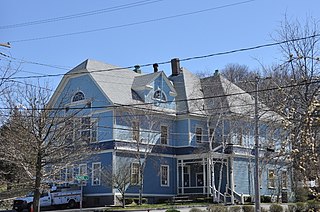
The Washington School is a historic school building at 8 School Street in Weymouth, Massachusetts. The 2+1⁄2-story wood-frame building was designed by Shepard S. Woodcock and built in 1887. The six-room building has characteristic Queen Anne styling, including asymmetrical massing, varied gable treatments, use of decorative fish-scale shingles, and an elaborately decorated entry porch.

The US Post Office-Weymouth Landing is a historic post office building at 103 Washington Street in Weymouth, Massachusetts. The single story stone building was built in 1941, and is locally distinctive as a rare construction in granite. The basic design of the building is similar to other post office designs of the 1930s and 1940s. It has a five-bay facade, three of which project, providing the entrance. The building is topped by a side-gable roof with a wooden cornice, with a louvered belfry topping the roof.

The Old Hose House is a historic fire house in Reading, Massachusetts. The Colonial Revival wood-frame building was constructed in 1902 for a cost of $1,180.50, plus $10 for the land on which it stands. The modestly-scaled building housed a fire truck until 1930, after which time it has served as home to community groups. The building was listed on the National Register of Historic Places in 1984.
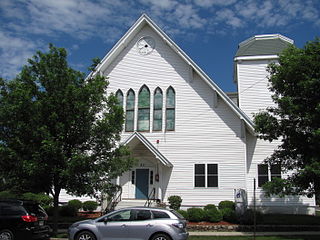
The First Unitarian Church is a historic former church building in Stoneham, Massachusetts. One of Stoneham's more stylish Gothic Revival buildings, the Stick style wood structure was built in 1869 for a Unitarian congregation that was organized in 1858. The building was listed on the National Register of Historic Places in 1984, and included in the Central Square Historic District in 1990. It presently houses the local Community Access Television organization.
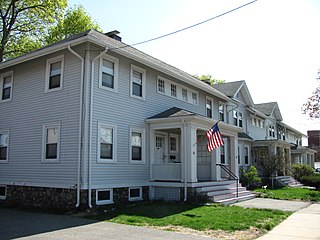
The building at 38–48 Richardson Avenue is a historic residential rowhouse in Wakefield, Massachusetts. Built c. 1912, is believed to be one of the oldest rowhouses in the town. They were built by Solon O. Richardson, Jr., on a portion of his family's estate. The building was listed on the National Register of Historic Places in 1989.

The Micah Williams House is a historic house at 342 William Street in Stoneham, Massachusetts. The 1+1⁄2-story Greek Revival cottage was built c. 1830 by Micah Williams. Unlike many Greek Revival buildings, which have the gable end facing the street, this one has the front on the roof side, a more traditional colonial orientation. Its facade is five bays wide, with a center entrance sheltered by a hip-roof portico with square columns. The house was built by Williams for his daughter.

The Wakefield Trust Company is a historic commercial building at 371 Main Street in Wakefield, Massachusetts. Built in 1924, it is one of three buildings on the west side of Main Street that give the town center a strong Classical Revival flavor. The building was listed on the National Register of Historic Places in 1989.

The West Ward School is a historic school at 39 Prospect Street in Wakefield, Massachusetts. Built in 1847, it is the only surviving Greek Revival schoolhouse in the town. The building was listed on the National Register of Historic Places in 1989. It is now maintained by the local historical society as a museum property.
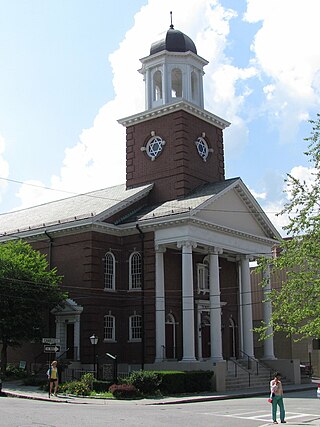
The Second Unitarian Church is a historic church and synagogue building at 11 Charles Street in Brookline, Massachusetts. Built in 1916 for a Unitarian congregation, it was acquired by the innovative Reform Jewish Temple Sinai congregation in 1944. It is a high quality example of Colonial Revival/Georgian Revival architecture, and was listed on the National Register of Historic Places in 1985.

The Goffstown Public Library is located at 2 High Street in Goffstown, New Hampshire. The building it occupies was designed by architects Henry M. Francis & Sons and was built in 1909. It is small Classical Revival building built of brick with stone trim, and was added to the National Register of Historic Places in 1995. It is one of the finest examples of Classical Revival architecture in the town, with a three-bay main facade whose central entrance projects slightly, and is topped by a pediment supported by Ionic columns.

The William Fogg Library is the public library of Eliot, Maine. It is located at the junction of Old and State Roads, in an architecturally distinguished building constructed in 1907 via a bequest from Dr. John S. H. Fogg in memory of his father William. The building was designed by C. Howard Walker, and was listed on the National Register of Historic Places on December 21, 1991.

The Housatonic Congregational Church is a historic church building at 1089 Main Street in Great Barrington, Massachusetts. Built in 1892 it is a prominent local example of Queen Anne Revival architecture, and was listed on the National Register of Historic Places in 2002. It is now home to the Unitarian Universalist Meeting of South Berkshire.

The Gilmanton Ironworks Library is a historic library building at 10 Elm Street in the Iron Works village of Gilmanton, New Hampshire. Built in 1916–17, it was the first Colonial Revival library building in Belknap County. The building, still serving as a branch of the Gilmanton public library system, was listed on the National Register of Historic Places in 1989.
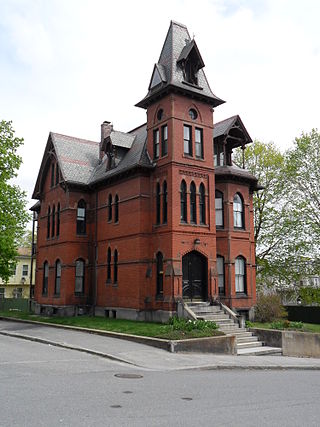
Amos P. Cutting was an American architect in practice in Worcester, Massachusetts. He entered practice in 1868 and developed a practice specializing in the design of churches and public buildings. Shortly before his death he organized the firm of Cutting, Carleton & Cutting; it maintained his specialties and outlived him by over thirty years.

Joseph Everett Chandler was an American architect. He is considered a major proponent of the Colonial Revival architecture.























